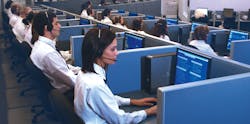Some of the security industry’s most valuable contributors are the ones who don a headset every day to respond to the emergencies happening at homes and businesses. They are absolutely “essential workers,” and their continued health and good work are paramount to maintaining our industry’s value during a pandemic situation.
The COVID-19 outbreak and resulting quarantines and stay-home orders issued by local governments will undoubtedly impact a monitoring center’s ability to staff its facilities and respond to alarms. It highlights the vital role that redundancy plays when it comes to security monitoring.
“It doesn’t take a catastrophe to compromise a monitoring center," explains Jim McMullen, President of wholesale monitoring provider COPS Monitoring. "What is more likely than a complete location failure is some local situation that increases alarm traffic and complicates a company's ability to staff – both of which can significantly impact response times. We have experienced tornadoes, hurricanes, blizzards, wildfires, and even riots at our various locations, which all can wreak havoc on response times. When something like that happens to us, our response times typically get better by using staff across all six locations. Some in the industry disagree that you need six monitoring centers (for redundancy), but they are there to mitigate situations like these.”
In addition to redundancy of operations, it is vital that both third-party and internally-run security monitoring centers do everything in their power to limit the ways that monitoring personnel can get sick. According to McMullen, COPS is closely following CDC recommendations, such as sanitizing high-traffic areas and touchpoints. “We use no-touch thermometers to take their temperature upon arrival to work, enforce frequent hand washing, sanitize areas with UV lights, non-dispatching employees are working from home, we have separated dispatch employees at safe distances, and several other means to help ensure they return home to their families healthy each day,” McMullen says.
One question is whether having so many people at home will increase or decrease the volume of emergency calls and alarms coming into the monitoring center. While he didn't share details of a formal study or evidence, McMullen speculates that the volume may decrease during this time. “A lot of false alarms are the result of people interacting with their systems,” he says. “If people aren’t arming/disarming as much (since they are home), one might imagine there may be fewer alarms.”
Editor's Note: This article appeared as a sidebar to our COVID-19 Integrator Roundtable.
About the Author
Paul Rothman
Editor-in-Chief/Security Business
Paul Rothman is Editor-in-Chief of Security Business magazine. Email him your comments and questions at [email protected]. Access the current issue, full archives and apply for a free subscription at www.securitybusinessmag.com.

